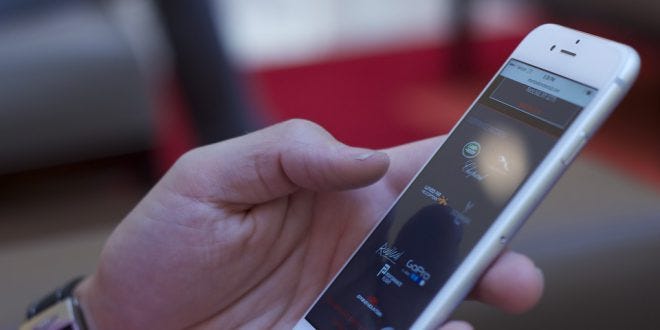An Appy Hour of Art

This winter, the Yale University Art Gallery (YUAG) and the Yale Center for British Art (YCBA) created audio guide apps to expand informational access to their works. Their launch, “Appy Hour,” was filled with excited visitors and museum staff celebrating the new app. My own experience of “Appy Hour,” however, was a more quiet affair. With one hour on a Friday afternoon to divvy up between the YUAG and YCBA, I began with the YUAG app’s 30-minute audio tour.
My tour began on the first floor, with gallery teacher Tony Colman, DIV ’19, discussing the interesting facial features of the terracotta Nok figures. The app then directed me upstairs to the Chinese sculpture Bodhisattva Avalokiteshvara in the Water-Moon Manifestation, Le Café de nuit (The Night Cafe) by Vincent Van Gogh, The Declaration of Independence, July 4, 1776 by John Trumbull, and, lastly, Rooms by the Sea by Edward Hopper. By the end of the tour, I learned that Van Gogh’s garish red-green color palette signals illness in his characters and that Trumbull spent more than 30 years to paint the exact likeness of his 48 figures.
One of the app’s most appealing aspects is this experience: that a Yale faculty member, alumni, or student who appreciates a piece’s value now has the chance share their opinions with you. The contributors’ enthusiasm is contagious, and I completed the 30-minute tour wishing I had more time to explore the gallery.
I then crossed the street to continue “Appy Hour” at the YCBA. Instead of selecting an audio tour, I manually entered the audio stop numbers of the pieces I found interesting. Standing in front of Sir Joshua Reynolds’ Mrs. Abbington as Miss Prue in “Love for Love” by William Congreve, I heard an analysis from Mark Hallett, Director of Studies at the Paul Mellon Centre for Studies of British Art. I listened to Glenn Adamson, a senior scholar at the YCBA, describe Yinka Shonibare’s playful interpretation of the British colonialism as depicted in Mrs. Pinckney and the Emancipated Birds of South Carolina.
The audio guide transformed my solitary time at both museums into an experience that was both simple and comfortable. I’ve always felt a bit self-conscious in museums; I’d try to focus on an art piece, think about how it made me feel and try to pinpoint what the artist was trying to convey, but then I’d feel so awkward about the presence of a security guard or another museumgoer standing next to me that I’d shuffle away to look at something else instead.
However, with the app in hand, I was not as easily distracted by other occurrences in the gallery. I was able to experience the gallery in relative solitude without sacrificing the knowledge gained on tours. For Stephanie Wiles, Director of the YUAG, one of the most exciting aspects of the audio guide app is its ability to share analyses of pieces from a variety of perspectives and not just the perspective of a single curator. Wiles praises the app, saying that it “allows us to reach out to art conservators, educators, and others who have taught in the galleries but are not necessarily curators.” Wiles adds, “The app gives people a chance to expand their thinking based on what a painting or sculpture might mean to someone else.”
Of course, the audio guide app won’t be a perfect fit for everyone, especially those who believe in experiencing art free from another person’s opinions. And while some people appreciate the opportunity to schedule in quick, worthwhile visits to the museum with the app, there are still people who enjoy going on physical tours of the collections led by curators and gallery guides. Nevertheless, Wiles believes that the app’s content can still provide valuable insight for visitors who do not have a lot of experience looking at art of certain regions, styles, or time periods.
To be honest, I was reluctant to download yet another app on my phone. A quick search of museum audio guide apps suggests that many museums are taking steps to digitize access to their art collections and add to their visitors’ experiences with self-guided tours. Increasing the number of audio guide apps aims to invite more people into conversations about art and culture. An app might be the first step for the YUAG and YCBA to plan inclusive social media campaigns like the MoMa’s #ArtSpeaks, where museum staff members can share how their life experiences have shaped how they view their favorite works.
Technology has fostered conversations about art by enhancing our experiences of museums and giving users the opportunity to pursue their curiosities. They generate conversations that begin with ourselves and eventually transcend into discussions independent of technology.
For now, with this app in hand, and my earbuds in, I come slowly before another art piece, prepared to meditate upon what the next curator, scholar, or student has to share with me.
YUAG and YCBA Audio Guide Apps was originally published in The Yale Herald on Medium, where people are continuing the conversation by highlighting and responding to this story.
